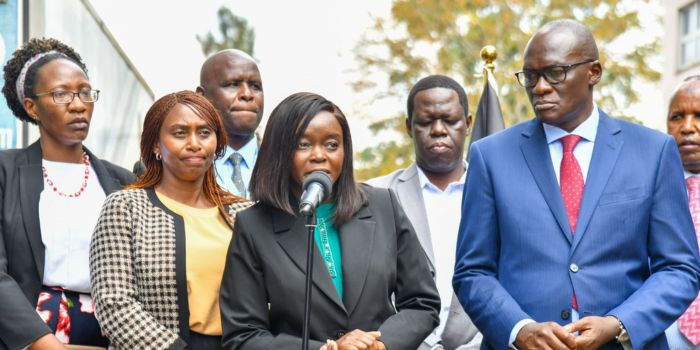Kenyans Flock to SHA as New Health Scheme Tops 12.5 Million Sign-Ups

The newly introduced Social Health Authority (SHA) health insurance scheme has swiftly passed 12.5 million registrations, just two million short of the now-defunct National Health Insurance Fund (NHIF). This milestone comes despite initial scepticism and confusion among Kenyans when the scheme was launched.
On Tuesday, nearly 400,000 new registrations were recorded, bringing the total to 12,540,117 subscribers. The transition from NHIF to SHA saw almost 10 million NHIF users automatically enrolled in SHA, according to internal data. This significant uptick marks a notable shift in public perception, following early resistance.
According to user data seen by Kenyans.co.ke, the new scheme has managed to transition 9, 975,011 users of the National Health Insurance Fund (NHIF) to the new scheme. According to the data, 395,187 people registered on Tuesday, October 1. A majority of the 12.5 million registered users—a majority are men.
In comparison, NHIF had approximately 14 million registered principal members and about 12.9 dependants, translating to approximately 22.8 million beneficiaries.
Ministry of Health’s Afya House Building in Nairobi, Kenya.
Photo
Ministry of Health
The rollout of SHA, aimed at improving healthcare access across the country, began with challenges as citizens voiced concerns over the scheme’s complexity and the technology used during registration. Despite these hurdles, the Ministry of Health has consistently pushed forward, introducing new measures to facilitate the process.
From today, Kenyans who visit public hospitals will be required to register under SHA to access medical services, even if they already hold NHIF cards. The government projects that SHA will generate Ksh148 billion annually, funds which will be used to bolster the national healthcare system. Health Cabinet Secretary Deborah Barasa disclosed this while addressing the Departmental Committee on Health, chaired by Endebess MP Dr Robert Pukose.
Barasa acknowledged that the registration process had only attracted just over two million subscribers by September, but this number surged to 12.5 million as of October 1. She added that the government has dispatched 5,000 internet-enabled tablets to all 47 counties to aid in the registration process, which will be activated in 15 counties today.
As SHA takes shape, private health facilities are also expected to procure the necessary digital tools to support the registration drive. Monitoring systems are already being set up within SHA’s operations centre to track progress. County Executive Committee members, alongside health officials and deputy county commissioners, will spearhead the rollouts in their respective counties, with governors offering additional support.
The new scheme aims to be more cost-efficient compared to NHIF. While NHIF struggled with administrative costs consuming up to 15 per cent of its funds, SHA plans to cap this at five per cent. This ambitious target is seen as a key element in ensuring the longevity and efficiency of the programme. However, some MPs raised concerns over the viability of SHA’s expansive goals.
During a parliamentary session, Lurambi MP Titus Khamala questioned the government’s readiness for the nationwide rollout, drawing parallels with the troubled implementation of the Competency-Based Curriculum (CBC) in the education sector. Medical Services Principal Secretary Harry Kimtai assured legislators that NHIF would continue to operate in tandem with SHA for the next seven years, maintaining a fallback system for legal and administrative purposes.
As Kenyans brace for higher deductions under SHA, concerns have emerged about the fairness of the contribution structure. The government will deduct 2.75 per cent of salaried workers’ pay, meaning someone earning Ksh50,000 will now pay Ksh1,375, while those earning Ksh100,000 will contribute Ksh2,750. This is significantly higher than NHIF’s flat deductions, where a person earning Ksh50,000 paid Ksh1,200.
These changes have sparked questions from both the public and lawmakers about the criteria used to calculate individual contributions. Acting SHA head Elijah Wachira revealed that the scheme will use a “means testing tool” with 17 specific questions to assess each person’s financial situation. Factors such as ownership of luxury items like expensive television sets will influence contribution amounts, causing many to question the fairness of the system.
Critics point out that even individuals in impoverished circumstances could be assessed for high contributions. In one instance, lawmakers tested the system using a poor man who owned nothing but a small, malnourished cow. To their surprise, the system classified the man’s household as liable to contribute Ksh20,000 annually. Wachira assured MPs that the means testing tool has now been refined, with the government categorising poor households into two groups to ensure fairer contributions.
Despite these controversies, the SHA scheme is gaining traction. The government’s challenge will be maintaining public trust as the transition continues and ensuring that the health sector benefits from the projected revenue surge.
Health Cabinet Secretary Debra Barasa when she appeared before Parliament in July 2024 for vetting before her eventual appointment.



